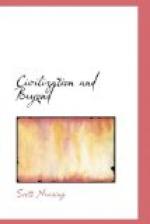In terms of social history the growth of structure has proceeded from the horde, tribe and clan to the family, village, city, city-state, nation, empire, civilization. These steps are not necessarily sequential. Under varying social conditions they have been determined and modified by particular historical situations. The smallest and most intimate building block of human society has been the family. The largest and most inclusive has been the civilization. The family as a social group has existed for long periods, over wide areas, in immense numbers. Civilizations have been few and often far between. They have arisen out of particular historical situations, played distinctive roles, written their own histories and made varying contributions to the sum total of human culture. In the long time intervals and the wide geographical distances that have separated civilizations human beings have lived within more local and less complex social structures.
Civilized human society is distinctive in structure. While it varies in detail from one civilization to another, its broad outline is unmistakable. Each civilization has been built, defended and perpetuated in and around cities.
Between civilizations, in time and space, most human communities have been self-sufficient. Whether as food gatherers, pastoral people or cultivators of the soil they have produced and consumed the food, shelter, clothing, implements and weaponry required for their survival.
The city, whether a political capital or a center of trade and commerce, was sharply separated from the self-sufficient countryside. The city, by its very nature, could not be self-sufficient. Food, building supplies and raw materials were not produced inside the city limits, but must be produced in the hinterland from which they were transported to the cities. City dwellers devised means of paying for the production, transportation and marketing of these necessary imports. The countryside can and does exist independently of the city because it can provide the goods and services on which its existence depends. The city, on the contrary, cannot exist without the supplies produced in the hinterland and transported to the city.
Urban centers of civilization have for their background a pastoral and agricultural source of food supplemented by fabrication, merchandising and financing. Instead of the occupational uniformity of the countryside, the city offers a wide range of occupations, increased productivity, quick and substantial profits resulting in a build-up of capital on one side and enlarged consumer spending on the other. Consequently the successful competitor in the race for supremacy develops productivity, accumulates wealth, expands capital spending, enlarges the scope of the arts, thereby augmenting the city’s attractiveness to business enterprise and migrants from the hinterland.
As the capital city grows in wealth and opportunity it requires larger imports of food, raw materials, building supplies, manpower. Growing internal need leads to greater external expansion. Economic, political, administrative and cultural needs not only increase the demands of the city on its existing hinterland, but they lead to a demand for a more widely extended hinterland.




